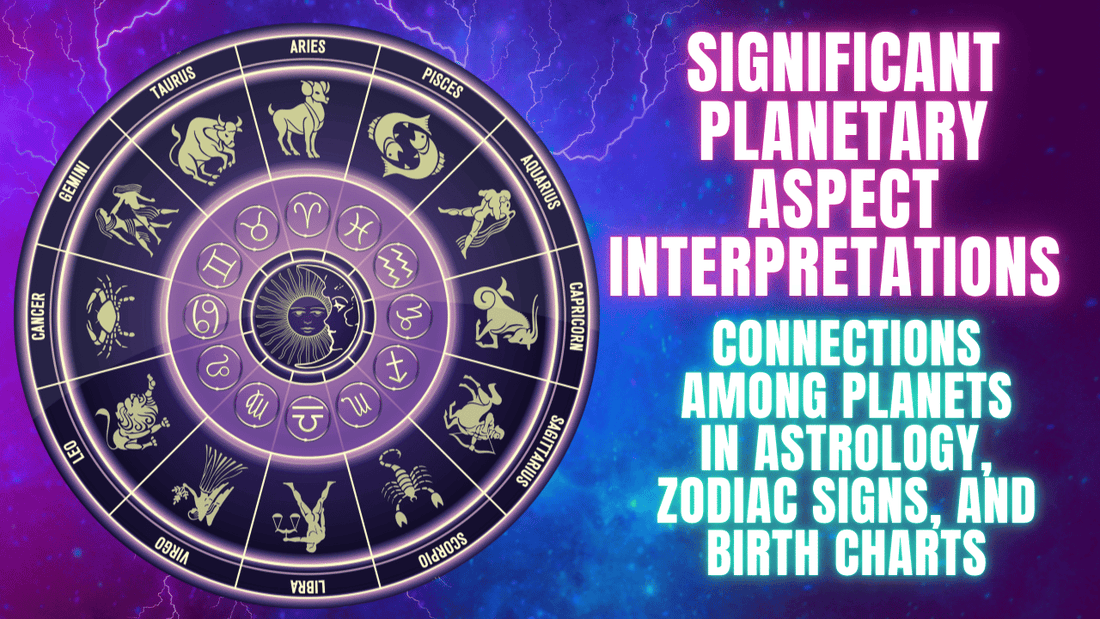
Significant Planetary Aspect Interpretations - Connections Among Planets in Astrology, Zodiac Signs, and Birth Charts
Share
Astrology is a profound and intricate system that seeks to understand the relationship between celestial bodies and their influence on human life. Central to this system is the concept of planetary aspects, which define the interactions between planets, zodiac signs, and the various sectors of a natal chart. These aspects are not just abstract ideas; they are vital elements that shape the dynamics of our personalities, relationships, and life paths. By analyzing these aspects, one can gain deeper insights into how different planetary energies combine, whether they create harmony or tension, and how they ultimately influence our lives.
What Are Planetary Aspects in Astrology?
Planetary aspects in astrology are defined by the specific angles formed between planets as viewed from Earth. In a natal chart, which is a symbolic map of the sky at the moment of your birth, these aspects reveal how planets relate to each other and the potential impact of these relationships. Each aspect has a unique meaning, reflecting the nature of the interaction between planets and how they influence the corresponding areas of life.
For instance, when you look at a natal chart, you see Earth at the center, surrounded by twelve zodiac signs, each occupying a sector of the sky. The planets within these sectors form angles with one another, creating aspects that determine whether their energies will blend harmoniously or clash. These aspects are the building blocks of astrological interpretation, allowing you to weave a detailed narrative about a person’s life and potential.
What Are Astrology Orbs?
In astrology, orbs refer to the allowable margin of error in the degrees between planets when forming an aspect. While the exact degree of an aspect is ideal, orbs allow for a range where the influence of the aspect is still felt. This means that even if planets are not perfectly aligned, their interaction can still be significant.
For example, if a sextile aspect is traditionally 60 degrees, an orb might allow for a range of 54 to 66 degrees. The closer the planets are to the exact degree, the stronger the aspect’s influence. Conversely, the further they deviate, the weaker the connection. Major aspects, such as conjunctions and oppositions, generally have larger orbs, typically around 5-6 degrees. Minor aspects, which are less potent, usually have tighter orbs of about 2-3 degrees.
Major Planetary Aspects in Astrology
Degrees: 0
Orb: 6
Keywords: concentration, unity, intensity
Signs apart: 0
Type: Dynamic - Initiates Action
Attributes: Same sign, modality, polarity, and element
Nature: Harmonious and disharmonious
A conjunction occurs when two planets are aligned at the same degree in the same zodiac sign, blending their energies into a single, powerful force. This aspect intensifies the traits of the involved planets, creating a strong focus in the areas of life they influence. Whether this aspect is positive or challenging depends on the nature of the planets. For example, a conjunction between Venus and Jupiter may bring abundant love and luck, while a conjunction between Mars and Saturn might result in frustration and restriction. Understanding the specific planets involved is crucial for interpreting this aspect accurately.
Sextile - The Flow of Supportive Energy
Degrees: 60
Orb: 6
Signs apart: 2
Keywords: ease, cooperation, support
Type: Passive - Does Not Create Action
Attributes: Same polarity, different elements
Nature: Harmonious
A sextile occurs when two planets are 60 degrees apart, fostering a relationship of mutual support and understanding. This aspect allows ideas and energies to flow smoothly between the planets, making it easier to take advantage of opportunities. While the sextile is a positive aspect, it is often passive, meaning it doesn't push for action but creates a comfortable environment where growth can occur naturally. This aspect is beneficial but can sometimes lead to complacency if not actively utilized.
Square - The Challenge of Growth
Degrees: 90
Orb: 6
Keywords: conflict, challenge, growth
Signs apart: 3
Type: Dynamic - Creates Action
Attributes: Same modality, different polarities
Nature: Disharmonious
The square aspect, formed at a 90-degree angle, represents tension and conflict between planets. This aspect challenges individuals to address the issues and obstacles it brings forth, often leading to significant personal growth. The friction created by a square forces change and adaptation, though the process can be difficult and frustrating. The key to mastering this aspect lies in embracing the challenges it presents and using them as opportunities for development.
Trine - The Gift of Natural Talent
Degrees: 120
Orb: 6
Signs apart: 4
Keywords: talent, ease, flow
Type: Passive - Does Not Create Action
Attributes: Same element
Nature: Harmonious
A trine, occurring at 120 degrees, is considered one of the most favorable aspects in astrology. It signifies a natural flow of energy between planets, often indicating innate talents and abilities. However, because the trine is so easy and harmonious, there can be a tendency towards laziness or taking things for granted. Those with prominent trines in their charts must ensure they don't let their natural gifts go to waste by failing to act on opportunities.
Opposition - The Duality of Conflict
Degrees: 180
Orb: 6
Keywords: opposition, tension, balance
Signs apart: 6
Type: Dynamic - Creates Action
Attributes: Same modality, same polarity
Nature: Disharmonious
An opposition, formed at 180 degrees, creates a push-pull dynamic between planets. This aspect often manifests as internal or external conflict, where opposing forces need to be balanced. The tension generated by an opposition can lead to significant personal growth if the individual learns to integrate the opposing energies. It can be a challenging aspect, but with effort, it can also lead to a harmonious balance between contrasting forces.
The Role of Planetary Aspects in Astrological Interpretation
Planetary aspects are the threads that weave the complex tapestry of a natal chart. They provide critical insights into how planetary energies interact, influencing the various facets of an individual’s life. By understanding these aspects, you gain the ability to interpret the subtle and overt forces that shape personality, behavior, and destiny. Whether harmonious or challenging, each aspect offers an opportunity for growth and self-awareness, making them essential components of astrological practice.
#astrology #natalchart #planetaryaspects #horoscope #zodiac #astrologytips #natalchartinterpretation #astroinsights #astrologyreadings #astrologycommunity #planetalignment #astrologywisdom #astrologicalaspects #conjunction #sextile #square #trine #opposition #celestialinfluence #cosmicenergy #astrologersofinstagram #astrologyfacts #astroblogger #planetaryinfluence #cosmology #astrologyandspirituality #zodiacsigns #astrology101 #astroanalysis #birthchartreading #starwisdom #stargazing #planetarypositions #celestialguidance #zodiacwheel #astrologyforecast #astrojourney #planetaryorbs #astrologicalguidance






